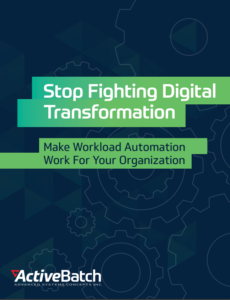IT operations automation — An overview of how to transform your IT operations
IT automation reduces manual tasks so IT operations can dedicate more resources to development and optimization. Learn why this is important and how it can benefit your organization.

What is operations automation in IT?
More and more organizations are looking to optimize their IT and business operations using automation. IT operations automation is the use of automated applications and systems to manage critical operations processes without the need for human intervention. Leveraging automation allows IT operations teams to spend more time completing high-value projects and strategic initiatives while drastically reducing manual errors, automatically troubleshooting issues and providing auto-remediation.
Why operations management must be automated
With the growing complexity of IT environments, manual processes are untenable. IT operations must adapt to the rapid changes, multitude of real-time data requirements and diverse technology integrations, making automation the answer for current complexity and necessary agility.
Data must be managed across on-premises and cloud-based data centers, dependencies must be passed across disparate platforms and new tools and technologies must be integrated and configured. IT teams can no longer rely on hard-coded properties, custom scripts and manual processes. To save time, increase reliability and reduce complexity, IT teams must amplify their use of process automation.
Examples of IT operations automation
IT operations automation has the potential to significantly improve both the customer experience and the need for manual intervention from the IT operations team. So much of an IT operations team’s time is spent on repetitive tasks. This presents the perfect opportunity to implement automation and demonstrate the clear value of the initiative.
There are many tasks that IT operations teams can automate, including:
- Onboarding new employees
- Provisioning new accounts
- Allocating equipment for new employees
- Resetting accounts with new passwords
- Support requests
- QA processes
Types of automation in operations management
Using a workload automation platform gives IT leaders a range of automation to address the needs of their organization. With various triggers, automated processes can be started on the same day or time, or they can begin based on events, such as when a file is received or when an earlier part of the process is finished. And for processes that only need to be run occasionally or in specific situations, they can be set up ad hoc.
Workload automation platforms also allow IT teams to streamline the development of new processes with intuitive UIs. With prebuilt and tested job steps, variables and templates, junior members of the team can easily and accurately build processes without the need for the skills of a more experienced developer.
“I&O leaders are investing in automation tools and technologies in response to organizational demands for speed and efficiency. The adoption of automation technologies is observed across multiple domains, including network, release management, cloud and IT operations, indicating a broad push to increase I&O’s speed and efficiency using automation.”
-Gartner, 2019-2021 I&O Automation Benchmark Report
Top 5 Benefits of IT Operations Automation
- Efficiency – Instead of waiting for an admin to manually provision virtual machines, automation software can be used to dynamically provision and de-provision VMs based on workload needs.
- Reliability – Minimize human error by automating routine, repetitive tasks like updating permissions or configuring servers and reducing the frequency and severity of outages. Automation platforms designed for IT operations also provide reliability for high-volume data transfers and simultaneous workload processing.
- Flexibility – IT automation solutions often provide direct integrations and low-code API accessibility, enabling IT operations teams to deploy and implement new technologies quickly or to assemble new, cross-platform processes without creating custom scripts.
- Visibility – By automating the monitoring of processes and systems, IT operations teams can collect data to optimize processes and resources, monitor and improve SLAs by redirecting resources to workloads at risk of overrunning, and automatically address failures with auto-remediation.
- Productivity – IT operations teams can accomplish more with fewer resources, relieving pressure on over-stretched staff and providing more time for IT to focus on long-term strategic goals that align with the business.
Don’t let IT complexity hamper your digital goals
Get the latest trends and data on what’s driving transformation and how IT teams address these challenges.
- Reliability – Minimize human error by automating routine, repetitive tasks like updating permissions or configuring servers and reducing the frequency and severity of outages. Automation platforms designed for IT operations also provide reliability for high-volume data transfers and simultaneous workload processing.
- Flexibility – IT automation solutions often provide direct integrations and low-code API accessibility, enabling IT operations teams to deploy and implement new technologies quickly or to assemble new, cross-platform processes without creating custom scripts.
- Visibility – By automating the monitoring of processes and systems, IT operations teams can collect data to optimize processes and resources, monitor and improve SLAs by redirecting resources to workloads at risk of overrunning, and automatically address failures with auto-remediation.
- Productivity – IT operations teams can accomplish more with fewer resources, relieving pressure on over-stretched staff and providing more time for IT to focus on long-term strategic goals that align with the business.
Advantages of automation in IT operations
As IT leaders face an ever-growing list of business requirements and no increase in their available resources, they must look to their existing technologies to meet these new demands.
Automation can be a true resource multiplier as it can be implemented quickly and securely with the right tools. Implementing or expanding automation delivers immediate results, allowing your team to focus on other high-value tasks. Starting with a pilot project, it is easy to demonstrate value within a specific area or department.
With a pilot project’s validation, IT leaders can expand their automation efforts. With a scalable workload automation platform, the features and functionality allow IT leaders to expand the reach of their automation capacity.
A rollout of automated processes may start with financial processes or data collection or may instead focus on IT tasks. With the ability to integrate with applications from on-prem to the cloud, workload automation platforms allow IT leaders to scale with the business as new systems and applications are added to the tech stack.
Building the foundation for modern IT operations
“The dynamic nature of digital business infrastructures is pressuring infrastructure and operations (I&O) organizations to support rapid application change and dynamic infrastructure scalability, and provide insights…. The continuous change and feedback loops needed for digitalization will change organizations’ monitoring, automation, service management and organizational strategies.”
-Gartner, Predicts 2019: IT Operations
Automating tasks and processes saves time, boosts productivity and reduces failures. But there’s more to the story. While automation enables IT to accomplish more with less, IT I&O teams still have room for improvement, i.e., optimization.
Technologies such as artificial intelligence, low-code REST API adapters and no-code development platforms are quickly evolving, enabling IT to create dynamic, flexible systems that can almost take care of themselves. As customer expectations and market demands continue to change, IT operations teams must leverage these new capabilities to stay ahead of digital transformation trends and competition.
Orchestration and infrastructure-as-code
Universal connectors, direct integrations and the ability to seamlessly execute APIs (.NET assemblies, RESTful services, command lines, stored procedures, etc.) – the foundation of orchestration, the ability to integrate and manage virtually any process from a single location.
Orchestration tools abstract away the complexity of underlying scripts, enabling IT to assemble end-to-end processes that manage related interdependencies regardless of the underlying technology. This makes it possible for IT to automate and manage processes across on-premises and cloud-based systems or between multiple cloud services to prevent vendor lock-in.
Additionally, by orchestrating automated processes from a single location, IT professionals can integrate provisioning, configuration and permissions tasks into end-to-end processes using infrastructure-as-code. And, because these processes and systems are centrally managed, monitoring can be extended across the enterprise.
AIOps
To effectively manage and optimize complex environments, IT organizations use artificial intelligence to identify bottlenecks, delays and failures before they occur. By collecting and analyzing vast volumes of data, AI tools can trigger auto-remediation workflows and redirect resources to prevent CPU overloads and process failures.
Additionally, using AIOps solutions provides visibility into all applications and system dependencies, drastically reducing the mean time to repair (MTTR) in the event of incidents.
Predictive AIOps has tremendous value when its benefits and use cases are extended to the automation environment. Operations and DevOps teams require flexible IT infrastructures that quickly adapt to dynamic, real-time demands.
Hyperautomation
Hyperautomation leverages artificial intelligence and machine learning to discover and automate as many business and IT processes as possible. Most organizations take an ad hoc approach to using automation, deploying multiple automation tools and leaving a lot of manual tasks to be automated. Those holes in the organization’s “patchwork” automation can be filled with a unified approach using low-code process development and intelligent orchestration tools.
Automated processes can then be simplified and optimized, completed in less time and with fewer errors and resources. AI and ML algorithms can coordinate computing resources, analyze historical and real-time data and take automated actions to prevent delays.
When the organization has automated as many tasks and processes as possible, it becomes much easier to quickly develop reliable, end-to-end processes that support new or evolving business goals. By coordinating a range of tools with a single, unified solution, organizations can quickly react to changing business and market demands.
Is NoOps the future of IT operations?
Technologies such as AIOps, cloud computing (SaaS/IaaS) and hyperautomation are allowing IT departments to drastically reduce the number of manual processes they are responsible for, with the potential for self-operating, fully automated NoOps environments.
A NoOps strategy includes intelligent automation tools to fully automate day-to-day operations and AI or ML to handle higher-level, more time-consuming tasks. Business team members and developers could then execute processes independently through a self-service portal and provision resources using infrastructure-as-code. Operations would be effectively hands-off.
“Cloud providers are continuing to climb the stack; rather than simply providing everything from the “hypervisor on down,” they are now—through their own focus on hyper-automation—taking on many core systems administration tasks including patching, backup, and database management, among others. Together, these capabilities create a NoOps environment where software and software-defined hardware are provisioned dynamically.”
-Deloitte, NoOps In A Serverless World
NoOps is more of an ideology that what can be automated must be automated to drastically reduce time spent on routine tasks and focus more resources on the software development lifecycle to iterate business processes faster. But NoOps presupposes cloud-native IT environments and doesn’t address evolving data regulations, new technology needs, or IT service management. So, while creating a NoOps environment in the cloud is technically possible, it likely won’t stay at NoOps for long.
One of the Deloitte article’s writers was later quoted as saying, “NoOps is not really attainable but it is an effective rallying cry.”
Frequently Asked Questions
Automation helps IT operations teams reduce the volume of routine tasks that must be manually completed, giving operations personnel more time to spend on higher-value projects. Automating minimizes the risk of human error, delays and operational costs. Automation platforms can connect, monitor and manage disparate applications and processes, providing auto-remediation and simplifying troubleshooting across operations.
IT operations automation refers to the automated processes, systems and applications that support day-to-day IT and business operations. IT operations automation extends to systems monitoring, network security, infrastructure automation and automated remediation, which can be critical to business continuity and disaster response plans. IT operations automation can drastically reduce manual interventions, improving efficiency and productivity.
Yes, ActiveBatch can automate IT operations. ActiveBatch is a workload automation and enterprise job scheduling solution that provides direct integrations with notable vendors, including HelpSystems, Microsoft, Informatica and VMware. With ActiveBatch, IT operations teams can drastically reduce human intervention by assembling end-to-end processes within a self-healing automation environment.
Ready to simplify your data warehousing with workload automation?
Schedule a demo to watch our experts run jobs that match your business requirements in ActiveBatch. Get your questions answered and learn how easy it is to build and maintain your jobs.








